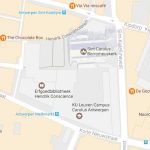Conscienceplein: start of a new era (2)
The library
Last Thursday I ended by talking about the building on the west side of the Conscienceplein: the sodalities. After the pope had abolished the jesuits in 1773 the buildings and everything in them were publicly sold. The building the sodalities had occupied in the previous years got different functions. It was a workshop, warehouse, dancing hall, public bar (a brewer’s advertisement can still be noticed) and so on. In 1879 the City Council bought the building to house the town’s library.

In fact there were two: a library of old, valuable books and manuscripts and a library where people could rent the more current type of books. That is why at the end of the 19th century a statue of Hendrik Conscience was placed in the niche of the sodality. Hendrik Conscience at that time was the most important author in Flemish literature, as popular in Flanders as Victor Hugo was in France.
From about 1622 till the French revolutionaries demolished it, a statue of the Holy Virgin has stood in the same niche.
You can find the entrance to the library now in Korte Nieuwstraat. Guided visits are organised and the 19th century ‘Nottebohmzaal’ certainly is worth a visit. These visits start from the green door in the south-west corner of the square. [http://www.consciencebibliotheek.be/en]
The church
The building opposite the sodalities/library is the old jesuits’ church devoted to Saint Carl-Borromeus. It is generally accepted that Rubens had a hand in the decorations of the façade and of the bell-tower which you can find at the back-side along Sint-Kathelijnevest.
It is clear the church is built in the typical jesuitstyle as laid out by the Roman Il Gesù Church. Giving a detailed description here would lead us too far, so have a little patience.
The square

In the 1960’s this square was the scene of an artistic uprising, joined by many young people in town to put an end to the reign of the Car. Using huge blocks of ice they blocked off the entrance to the square for cars. Musicians, artists, dancers and pedestrians took over the space. The uprising was a success and not only the square, but also the surrounding streets became the very first pedestrian zone in Antwerp. Of course for weddings and funerals car can still enter the square.
